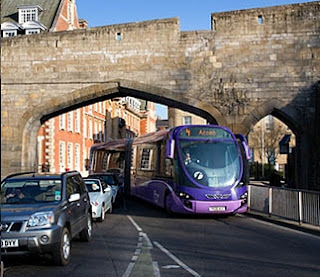--------------------------------------------------------------------------
Missed this one!
Boris drives the new bus out of the shed (here)
at Wright's works in Ireland.
Don't rush it Boris, you don't want to bend it!
See yesterday's blog "The Iconic British Bus" (here)
--------------------------------------------------------------------------
Today: the sign of four ...... but not the celebrated Sherlock Holmes story.
First's "ftr" project began in York way back in 2006 with the high profile introduction of sleek and spectacular Wright-bodied "Streetcar" buses on route 4.
fbb took a ride early on and it was, without a doubt, a disaster. The buses originally carried on-board self-service ticket machines which were frustratingly complicated to use and frequently prone to complete failure. There was nothing at stops to say "exact fare only" and nothing to say what the fare was, so fbb couldn't pay.
A chum delved into the depths of his pocket and together they cobbled together enough for the journey. The threats of disemboweling and deporting to the antipodes for non-payment of fare offered a truly friendly welcome to the new face of public transport!
The driver (called a "pilot" on First's ftr) was isolated from passengers and thus unable to offer advice and help for the confused. The GPS "next stop" system blacked out twice and struggled to regain its composure.
The stress of driving? What about the stress of travelling on ftr?
So when a similar scheme started in Leeds, also route 4, it was decided to drop the hi-tech and replace automatic machines with reliable "people". As with Sheffield's trams, conductors were back.
Swansea's scheme, the third ftr route 4, was delayed until Leeds was working properly and, because the infrastructure in Swansea is designed and branded as "metro", it does seem to work better than the other two.
And, perhaps, therein lies ftr's fault lines. If it really is "a bus that thinks it's a tram" then the services need tram-like infrastructure; loadsa bus lanes, significant lengths of bus-only road, segregation from other vehicles and, equally importantly, segregation from other buses.
But even Swansea is far from perfect. A recent article in "Buses" magazine revealed poor bus stop information with a non-working "real time" display at the Morriston Hospital terminus.
What real time display?
As well as conductors, the final ignominy ...
... is the replacement of ftr vehicles with ordinary one-man single deckers in the evenings and on Sundays.
This ftr-liveried bus is branded as "baby ftr" because the York service 4 has been extended to a new bit of the University and often there aren't enough purple bendies to keep the daytime frequency at every 10 minutes.
So, is this the ftr of bus travel?
Possibly in Swansea if the bits and bobs can be made to work, but less convincingly in Leeds and York? Even in Swansea, a service frequency of only every 12 minutes (Monday to Friday) every 15 minutes (Saturday) is hardly a dramatic statement of ftr bus service quality.
fbb has to admit to second-hand information for Leeds and Swansea from various chums, so will be on stronger ground tomorrow when he looks in more detail at the York scheme.
Next blog : due Wednesday November 23rd
-----------------------------------------------------------------------------------
"Omnibuses" blog talked about ftr yesterday (read here).
Pure coincidence : fbb's muse inspired him
way back on 3rd November
-----------------------------------------------------------------------------------










I happened to visit York in the first week of ftr. There were already conductors, but they could only issue single tickets. I wanted a First Day as I had planned to make at least three journeys in the city that day. The result - a complimentary ride.
ReplyDeleteYou could also mention the poorly thought-out design of the stops in York, such that wheelchair users' access to and from the bus is blocked by the location of the stop pole or shelter!
ReplyDeleteDaddysgadgets : I think "conductors" appeared in the very early stages to "assist" passengers with the technology and to collect fares when the gubbins failed. By my visit several weeks later they had evaporated, but the machines were still unreliable.
ReplyDelete